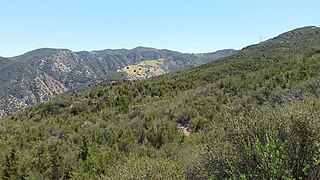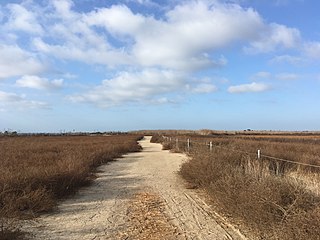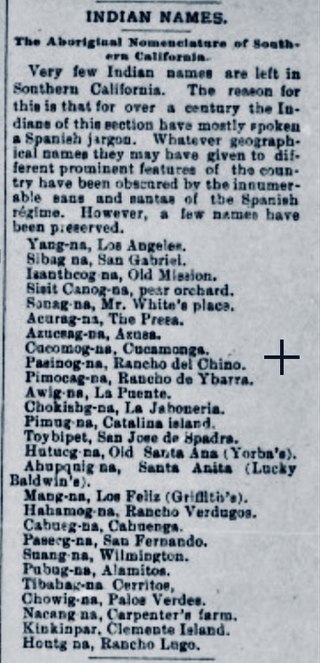Related Research Articles

Mission San Gabriel Arcángel is a Californian mission and historic landmark in San Gabriel, California. It was founded by the Spanish Empire on "The Feast of the Birth of Mary," September 8, 1771, as the fourth of what would become twenty-one Spanish missions in California. San Gabriel Arcángel was named after the Archangel Gabriel and often referred to as the "Godmother of the Pueblo of Los Angeles."

The Tongva are an Indigenous people of California from the Los Angeles Basin and the Southern Channel Islands, an area covering approximately 4,000 square miles (10,000 km2). In the precolonial era, the people lived in as many as 100 villages and primarily identified by their village rather than by a pan-tribal name. During colonization, the Spanish referred to these people as Gabrieleño and Fernandeño, names derived from the Spanish missions built on their land: Mission San Gabriel Arcángel and Mission San Fernando Rey de España. Tongva is the most widely circulated endonym among the people, used by Narcisa Higuera in 1905 to refer to inhabitants in the vicinity of Mission San Gabriel. Some people who identify as direct lineal descendants of the people advocate the use of their ancestral name Kizh as an endonym.

The Santa Ana River is the largest river entirely within Southern California in the United States. It rises in the San Bernardino Mountains and flows for most of its length through San Bernardino and Riverside counties, before cutting through the northern Santa Ana Mountains via Santa Ana Canyon and flowing southwest through urban Orange County to drain into the Pacific Ocean. The Santa Ana River is 96 miles (154 km) long, and its drainage basin is 2,650 square miles (6,900 km2) in size.

The Santa Ana Mountains are a short peninsular mountain range along the coast of Southern California in the United States. They extend for approximately 61 miles (98 km) southeast of the Los Angeles Basin largely along the border between Orange and Riverside counties.

The Back Bay is the colloquial term for the inland delta in Newport Beach, California. It connects the Upper Newport Bay with the Newport Harbor. It is a nature reserve home to several species of birds with hiking and biking trails. The bay is recognized for protection by the California Bays and Estuaries Policy.

Puvunga is an ancient village and sacred site of the Tongva nation, the Indigenous people of the Los Angeles Basin, and the Acjachemen, the Indigenous people of Orange County. The site is now located within the California State University, Long Beach campus and surrounding areas. The Tongva know Puvunga as the "place of emergence" and it is where they believe "their world and their lives began". Puvunga is an important ceremonial site and is the terminus of an annual pilgrimage for the Tongva, Acjachemen, and Chumash.
Olive is an unincorporated parcel of about 32.67 acres (132,200 m2) entirely surrounded by the city of Orange, located along Lincoln Avenue, between Eisenhower Park and Orange Olive Road.

The San Joaquin Hills are a low mountain range of the Peninsular Ranges System, located in coastal Orange County, California.

Newport Bay, in Southern California, United States, is the lower bay formed along the coast below the Upper Newport Bay, after the end of the Pleistocene. It was formed by sand, brought by ocean currents from the Santa Ana River and other rivers to the north, which constructed an offshore beach, now called the Balboa Peninsula. The bay was named by the Spanish Bolsa de Gengar in the 18th century, to refer to the nearby Tongva and Acjachemen village of Genga. An estuary of the Santa Ana River in the late 19th century, it was dredged to form Newport Harbor, the harbor of Newport Beach.

Puhú was a major residential village in the Santa Ana Mountains shared by the Tongva, Acjachemen, Payómkawichum, and Serrano near Santiago Peak. The village resided approximately 600m above sea level in the upper areas of the Black Star Canyon. The village was at its height from the years 1220–1770. The village retained its multi-seasonal occupancy and economic and political systems up until its destruction and a communal massacre in 1832.

Genga, alternative spelling Gengaa and Kengaa, was a Tongva and Acjachemen village located on Newport Mesa overlooking the Santa Ana River in the Newport Beach and Costa Mesa, California area which included an open site now referred to as Banning Ranch. Archaeological evidence dates the village at over 9,000 years old. Villagers were recorded as Gebit in Spanish Mission records. The village may have been occupied as late as 1829 or 1830.

Hutuknga was a large Tongva village located in the foothills along the present channel of the Santa Ana River in what is now Yorba Linda, California. People from the village were recorded in mission records as Jutucabit. Hutuknga was part of a series of villages along the Santa Ana River, which included Lupukngna, Genga, Pajbenga, and Totpavit. The Turnball Canyon area is sometimes falsely associated with Hutuknga.
Pajbenga, alternative spelling Pagbigna and Pasbengna, was a Tongva village located at Santa Ana, California, near the El Refugio Adobe, which was the home of José Sepulveda. It was one of the main villages along the Santa Ana River, including Lupukngna, Genga, Totpavit, and Hutuknga. People from the village were recorded in mission records as Pajebet,Pajbet, Pajbebet, and Pajbepet.
Ahunx ("elevated") was a village site significant to the Payómkawichum and Acjachemen located between the old town of El Toro and Tomato Springs.

Moyongna, alternatively spelled Moyonga, was a coastal Tongva village or landmark site located near the entrance of Newport Bay in Newport Beach, California near Corona del Mar. As a coastal village, the usage of te'aats was likely important to the village's people. Nearby coastal villages included Genga, located on Newport Mesa, and Lupukngna, located near the mouth of the Santa Ana River.

Alume was a large Acjachemen village located at the foot of Santiago Peak, upstream from the village of Putiidhem ,within what is now O'Neill Regional Park near the Trabuco Adobe, which was built in 1810 as an outpost of Mission San Juan Capistrano. The village was also recorded as Alaugna and as El Trabuco in San Juan Capistrano mission records, and is also referred to as Alauna, Aluna, and Alona. The village was also acknowledged by the Payómkawichum.

Lupukngna was a coastal Tongva village that was at least 3,000 years old located on the bluffs along the Santa Ana River in Huntington Beach near the Newland House Museum. Other nearby coastal villages included Genga, located in West Newport Beach, and Moyongna, located down the coast near Corona del Mar. The village has also been referred to as Lukup and Lukupa. The village has been chronicled in the history of Costa Mesa, California.

Piwiva was a Acjachemen village located at the confluence of San Juan Creek and Cañada Gobernadora tributary in what is now Rancho Mission Viejo, California. The name for the village was closely related to the Payómkawichum word for wild tobacco piivat. It was located north of Mission San Juan Capistrano, downstream from the village of Huumai and upstream from the village of Sajavit. Alternative names for the village include Pii'iv, Pivits, and Peviva.
Paxauxa was a shared Tongva and Payómkawichum village site located at what is now Corona, California along Temescal Creek. Villagers may have appeared in baptismal records at Mission San Juan Capistrano as being from the village Axaxa. Nearby villages included Poruumanga and Shiishongna. It is sometimes alternatively spelled Pakhavka.

Guashna was a Tongva village located at Playa Vista, Los Angeles at the mouth of Ballona Creek. The site has also been referred to as Sa'angna, with various sources debating whether Sa'angna, meaning "place of tar," was a regional referent rather than a village name or whether it was a separate nearby village. The initial place name was said to be Sa'an; the village suffix "ngna" was added by Bernice Johnston to her 1962 map of Gabrieleño villages "despite her having found no mention of the term in baptismal records." Sa'angna is also not to be confused with Suangna. The Tongva referred to the Ballona Wetlands as Pwinukipar, meaning "full of water." Another alternate name may Waachnga.
References
- 1 2 Papers on Great Basin Prehistory. University of California Archaeology Research Facility, Department of Anthropology. 1968. p. 138.
- ↑ Martínez, Roberta H. (2009). Latinos in Pasadena. Charleston, SC: Arcadia. p. 10. ISBN 978-0-7385-6955-0. OCLC 402526696.
- 1 2 McLendon, Sally (1999). Cultural Affiliation and Lineal Descent of Chumash Peoples in the Channel Islands and the Santa Monica Mountains: Final Report, Volume 2. National Park Service. p. 3.
- ↑ Grenda, Donn R.; Doolittle, Christopher J.; Altschul, Jeffrey H., eds. (1998). House pits and middens : a methodological study of site structure and formation processes at CA-ORA-116, Newport Bay, Orange County, California. Tucson, Ariz.: Statistical Research Inc. p. 17. ISBN 978-1-879442-66-5.
- 1 2 Catalysts to complexity : late Holocene societies of the California coast. Jon Erlandson, Terry L. Jones, Jeanne E. Arnold, Cotsen Institute of Archaeology at UCLA. Los Angeles: Cotsen Institute of Archaeology at UCLA. 2002. pp. 64–65. ISBN 978-1-938770-67-8. OCLC 745176510.
{{cite book}}: CS1 maint: others (link) - ↑ Santa Ana River Main Stem and Santiago Creek: Environmental Impact Statement. 1978. p. 21.